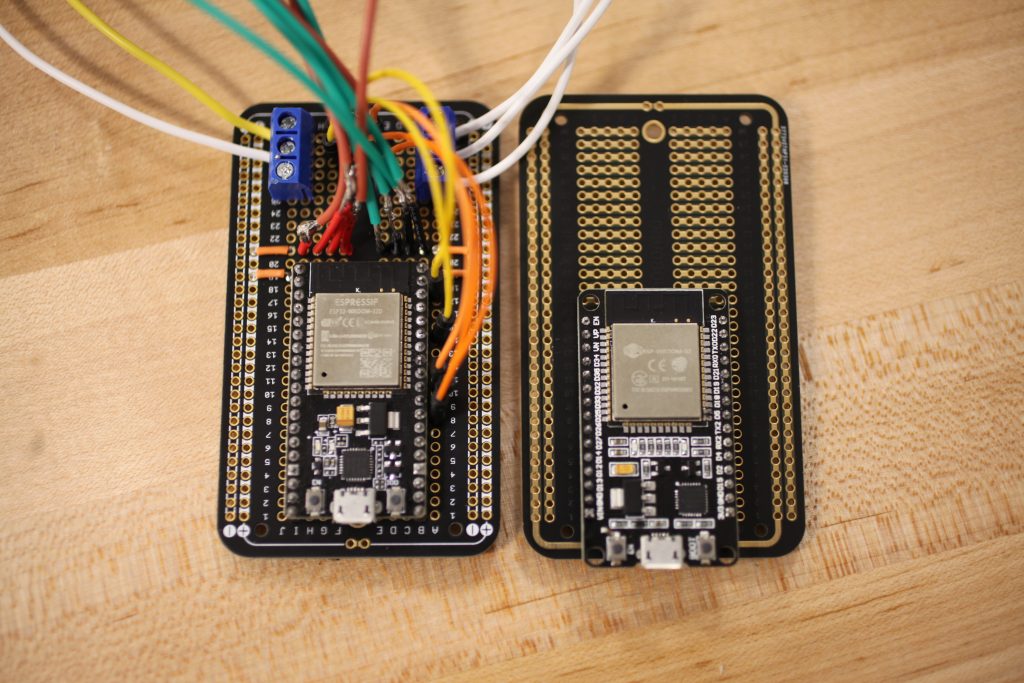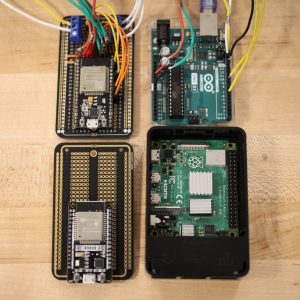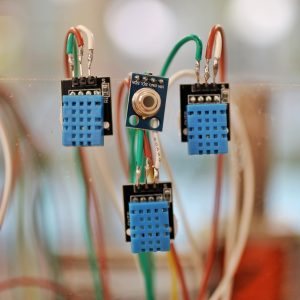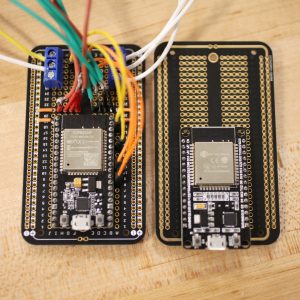Hello, Welcome to our project page!
Cryogenic electron microscopy (CryoEM) is one of the most attractive approaches in the field of structural biology. In 2017, Nobel Price in Chemistry was awarded to the work that develops CryoEM for “high-resolution structure determination of biomolecules in solution”. Recent advances in hardware and algorithms improve the performance of CryoEM significantly but the operation processes are still complex and cumbersome, requiring expansive equipment.
For example, there are many commercial products in the picture below that help researchers vitrify CryoEM samples. They usually cost tens of thousand of dollars, whereas the embedded software lacks versatility when preparing samples. Also, the equipment has a relatively closed system, which has basic functions but is unextendible. Although it satisfies the demand for sample vitrification, it is difficult to have connections with external devices.

Here we demonstrated a temperature and humidity monitoring and regulation system for the “Shake-it-off” sample plunge-freezing platform, which is an open-source sample vitrification device developed by John Rubinstein. As shown in the picture below, the whole system is built on a stainless steel plate and covered with a laser-cut PMMA enclosure.
Briefly, the system comprises three parts:
1. The CryoEM Sample Preparation Platform (in the top dashed box): This part is enclosed in the PMMA chamber and has all the functioning components for the sample vitrification including the structural framework, mechanical motor, sensors, heater, fan and humidifier. Details can be found in the shake-it-off device subpage.
2. The Environment Regulation Control (left bottom box): Here we used Arduino and ESP32 to realize real-time temperature and humidity monitoring and regulation. The DHT11 sensor and IR thermometer are used for monitoring. Three fans and a heating pad are used for the interior temperature adjustment. A IR thermometer is installed at the side of heating pad for the PID control of temperature. The details can be found in the subpage of Sensors and PID control. We also add a master ESP32 to realize remote monitoring, the details can be found in the subpage of Data Transmission.
3. The Plunge-Freezing Control part (right bottom box): We used a Raspberry Pi to control the solenoid and blotting motor in the plunge-freezing devices in the chamber, the detailed devices can be found in the subpage of shake-it-off device subpage and the python code can be found in Dr. John Rubinstein’s Github page.

OBJECTIVES
Primarily, we are aiming to establish a sample vitrification platform with the function of real-time temperature and humidity. All of the components used in this system should be programmable to fulfill the needs of integrating exterior devices such as function generators, high-speed cameras, and liquid dispensers. The project objective is the breakdown below:
- Clarify the functions and performances we need from the system and find out the proper sensors, microcontrollers, mechanical parts, structural framework, electrical components, and temperature & humidity regulating devices.
- Design the circuits for the sensors, MCUs, and data transmission devices.
- Calibrate the prepared sensors with standard reference.
- Connect the separated devices together, test each part and collect temperature and humidity data.
- Use the established sensing systems to support the development of heating PID control for temperature regulation.
- Design and fabricate the enclosure of the plunge-freezing system and electronics then assemble all systems together.
- Furthermore, if the project runs smoothly, more components such as liquid atomizer, fan, heater, and thermoelectric cooler Peltier can be included to actively tune the ambient environment.
INNOVATIONS

In this project, we plan to build an open-source environment regulation platform for CryoEM sample preparation with a combination of the shake-it-off plunge-freezing device since it doesn’t have the function of ambient condition control. Also, the open chamber system is liable to add or change components and connect external supporting devices.
- Temp & RH regulation: Since humidity and temperature are two critical factors that have a remarkable influence on the CryoEM sample quality, inside the operation chamber, they will be monitored with IR thermometer, K-Type thermocouple, and DHT11 humidity and temperature sensor. The humidity will be controlled by the fan and desiccant bags and the temperature will be controlled by the heating pad and fans.
- Dynamic PID control: The sensors in the system and dynamic PID control of temperature and humidity will be controlled by the an Arduino microcontroller. The data communication between sensors and regulators are developed with two ESP32 microcontrollers to achieve real-time ambient condition monitoring and regulation.




APPROACHES
- Sensors: To monitor ambient condition inside the chamber, we used DHT11 sensor, IR thermometer and K-TYPE thermocouple. They are compatible with a broad range of MCUs and easy to obtain.
- MCUs: In this project, we use three types of MCUs for controlling including Arduino, ESP32, and Raspberry Pi. The tutorial of how to use these MCUs can be found in the section of PRESENTATION at the end of this page.
- Data Transmission: Two ESP32 is employed here to realize monitoring data transmission and remote control of the system. One ESP32 serves as slave to collect data and send to the master ESP32. The details can be also found in the section of PRESENTATION at the end of this page.
- Shake-it-off Device: The Rubinstein device contains plunging solenoid, structural framework, controlling circuits and a cold tank. The plunging-freezing is achieved by turning on and off the solenoid to active the electromagnetic force, which can either hold the forceps up by repel the metal cylinder or release the cylinder and the forceps attached on it to send the grids at the tip of forceps to liquid ethane for flash-freezing. The on/off status of solenoid id controlled by a Raspberry Pi with python code. The cold tank has two separate containers for ethane in the container at center and liquid nitrogen in the outer space. The liquid nitrogen is used for maintain the temperature of ethane and its surrounding environment to prevent the liquid ethane from evaporate too fast.
- Laser-cut: We reshape the PMMA board by using a 60 W infrared laser cutter with 100% speed and 50% power. The CAD is used to design the geometry and the pattern is send to laser cutter with Adobe Illustrator.
- Soldering: At the final stage of this project, we replace the jump wires and bread board with thicker copper wires and PCB solderable breadboard then soldering everything together to ensure the stability of the system.





Future Work
- Currently we are using DHT11 and IR thermometer to monitor the ambient temperature and humidity, but the actual temperature of ethane container is still unknown. We plan to use a K-Type thermocouple to detect the temperature of the ethane container by attaching it on the wall of ethane container, which will help us to maintain the temperature of ethane cryogen to let it stay in the liquid phase.
- At present, we are using desiccants, copper mesh and three fans worked at full power to decrease and homogenize relative humidity inside the chamber. In the future, humidifier, dehumidifier and humidity sensor with better performance will be integrated to the system to realize fast and accurate humidity PID control.
- Two ESP32 boards perform remote temperature and humidity monitoring at this stage, which will be upgraded to remote control in the future. Then we can turn on/off and tune the system remotely out of lab.
References
MCUs control and communication:
- https://github.com/adafruit/DHT-sensor-library
- https://github.com/adafruit/Adafruit_Sensor
- https://create.arduino.cc/projecthub/akshayjoseph666/interface-i2c-16×2-lcd-with-arduino-uno-just-4-wires-273b24
- https://www.youtube.com/watch?v=F_h22AXZ7ts
- https://youtu.be/zABnN4lPvcM
- https://www.quora.com/How-do-I-export-data-from-PuTTY-to-Excel
- https://www.electronics-lab.com/project/infrared-thermometer-arduino-mlx90614-temperature-sensor/
- https://learn.adafruit.com/ad8495-thermocouple-amplifier/arduino
- https://forum.arduino.cc/t/adafruit-ad8495/535167
Academic Literatures about CryoEM:
- Nakane, T.; Kotecha, A.; Sente, A.; McMullan, G.; Masiulis, S.; Brown, P. M. G. E.; Grigoras, I. T.; Malinauskaite, L.; Malinauskas, T.; Miehling, J.; Uchański, T.; Yu, L.; Karia, D.; Pechnikova, E. V.; de Jong, E.; Keizer, J.; Bischoff, M.; McCormack, J.; Tiemeijer, P.; Hardwick, S. W.; Chirgadze, D. Y.; Murshudov, G.; Aricescu, A. R.; Scheres, S. H. W., Single-particle cryo-EM at atomic resolution. Nature 2020, 587 (7832), 152-156.
- Yip, K. M.; Fischer, N.; Paknia, E.; Chari, A.; Stark, H., Atomic-resolution protein structure determination by cryo-EM. Nature 2020, 587 (7832), 157-161.
- Cheng, Y.; Grigorieff, N.; Penczek, Pawel A.; Walz, T., A Primer to Single-Particle Cryo-Electron Microscopy. Cell 2015, 161 (3), 438-449.
- Yin, C.-C., Structural biology revolution led by technical breakthroughs in cryo-electron microscopy. Chinese Physics B 2018, 27 (5), 058703.
- Renaud, J.-P.; Chari, A.; Ciferri, C.; Liu, W.-t.; Rémigy, H.-W.; Stark, H.; Wiesmann, C., Cryo-EM in drug discovery: achievements, limitations and prospects. Nature Reviews Drug Discovery 2018, 17 (7), 471-492.
- Khoshouei, M.; Radjainia, M.; Baumeister, W.; Danev, R., Cryo-EM structure of haemoglobin at 3.2 Å determined with the Volta phase plate. Nature communications 2017, 8 (1), 1-6.
- Wong, W.; Bai, X.-C.; Sleebs, B. E.; Triglia, T.; Brown, A.; Thompson, J. K.; Jackson, K. E.; Hanssen, E.; Marapana, D. S.; Fernandez, I. S., Mefloquine targets the Plasmodium falciparum 80S ribosome to inhibit protein synthesis. Nature microbiology 2017, 2 (6), 1-9




